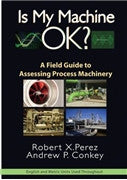Is My Machine OK? A Field Guide to Assessing Process Machinery
|
|
Bonus Pack Included
with this item. |
- Vendor: Industrial Press
- Type: Book
Description
This compact and unique reference provides those who deal with industrial machines a handy guide for assessing the potential risk of failure and offers a solid basis for reliable and safe machinery operation. Combining the most commonly used assessment tools into one source, it is meant to be taken into the field by operators, plant supervisors, maintenance personnel, and reliability professionals in order to make informed decisions about their equipment.
- The only reference available that assembles a body of sound operating practices.
- Includes guidelines for gauging machine maladies, such as vibration and pulsation.
- Provides guidelines for key machine factors, such as lubrication condition, temperature limits, alignment, and balance standards.
- Presents numerous relevant examples within each section aimed at helping readers understand the proper application of the various assessment methodologies.
Author:
Robert X. Perez and Andrew P. ConkeyPublished:
2012Format:
PaperbackPages:
288Table Of Contents:
-
A Brief Introduction to Machinery Monitoring
- Why Do We Monitor Machines?
- Assessing Process Machinery
- Monitoring Systems
- Medical Monitoring Analogy
- Some Basic Advice
-
General Machinery Monitoring Guidance
- Where to Start?
- When Should a Machine Be Considered Critical Enough to Justify Continuous Monitoring?
- Machinery Monitoring Recommendations Based on Criticality
- Simplified Method of Economic Justification
-
Machinery Assessment Steps
- The Machinery Assessment Maze
- What Machine Iinformation Do I Need Before Getting Started?
- What Analysis Equipment Do I Need?
- The Potential to Failure Time Interval
-
Machinery Data Analysis
- Pattem Recognition
- Trends
- Correlations
- Combination Trends
- Some Rules of Thumb
-
How to Audit Operating Machinery
- Field Audit Form
-
Risk Ranking Machinery Issues
- Recommendations and Risk Ratings
-
How to Assess Centrifugal Pump Performance
- Why Use Centrifugal Pumps?
- Head Versus Pressure
- Centrifugal Pump Performance
-
How to Conduct a Steam Turbine Field
- Inspection
- Steam Turbine Types
- What is the Steam Turbine Speed Telling You?
- Assessing Steam Turbine Vibrations
- Steam Turbine Temperature Assessment
- Common Govemor Control Problems
- Other Inspections
- Good Rules of Thumb for Steam Turbines
-
AC Electric Motors
- Controls
- Instrumentation
- The Effects of Voltage Unbalance
- Insulation Classes and Their Thermal Ratings
- Re-greasing Electric Motors
- Unique Vibration Characteristics of Electric Motors
- Notes About Motors
- Useful Electric Motor Formulas and Tables
-
Allowable Piping Vibration and Dynamic Strain
- Dynamic Strain and Stress Guidelines
-
Data Collection Tips
- Common Types of Field Sensors
- What Vibration Sensor Should I Use?
- What Are the Components of Vibration?
- Guidelines for Accelerometer Usage
- Accelerometer Measurement Locations
- Vibration Analysis Tips
-
Machine Vibration Severity Guides
- Velocity Guidelines
- Acceleration Guidelines
- Vibration Guidelines for Displacement, Velocity, and Acceleration
- Vibration Guidelines for Displacement Measurements in Fluid Film Bearings
- Vibration Guidelines for Reciprocating Compressors and Engines
-
Basic Vibration Analysis Part I
- Common Machinery Problems Associated with Vibration
-
Basic Vibration Analysis Part II
- Vibration Analysis Terms and Tables
- Examples of Real Vibration Spectra
-
Detection of Machinery Faults Using Utrasonics
- Monitoring Bearing and Lubrication Condition
- Monitoring Reciprocating Machinery
- Other Applications
-
Dynamic Pressure Measurements
- Pressure Transducer Installation
- Piezoelectric Transducers
- Allowable Pulsation Levels for Reciprocating Compressors
- Allowable Pulsation Levels for Reciprocating Pumps
-
How to Identify Machinery, Piping, and Acoustic Resonances
- Rotor Critical Speeds
- Identifying Piping Resonances
- Identifying Critical Speeds and Resonances
- The Quality Factor or Q
-
Temperature Limits
- How Do Infrared Thermometers Work?
- Bearing Temperature Trending
- Bearing Temperature Guidelines
- Compressor Temperature Monitoring
- K Values for Common Gases
-
Lubrication
- Lubrication Overview
- Key Steps to aCost-Effective and Reliable Lubrication Program
- Oil Analysis Limits and Targets
- Cleanliness Codes
-
Machinery Rules of Thumb
- Alignment
- Balancing
- Static Shaft Bow
- Mechanical Seal Misalignment Guidelines
- Joumal Bearing Clearance
- Piping Guidelines
- Centrifugal Pump Wear Rings
-
Lean Equipment Compliance
- Applying TPM to Industrial Equipment
- Applying Poka-Yoke
- Management Audit and Follow-Up
- Glossary of Lean Equipment Compliance (LEC) Terms
-
Final Thoughts
- Importance of Adding Value
- Keys to a Successful Machinery Assessment Program
- Ethics and Intellectual Dishonesty
- Go Forth and Analyze
- Appendix A: Glossary of Machinery Assessment Terms
- Appendix B: Useful Conversions and Equations
- Index




